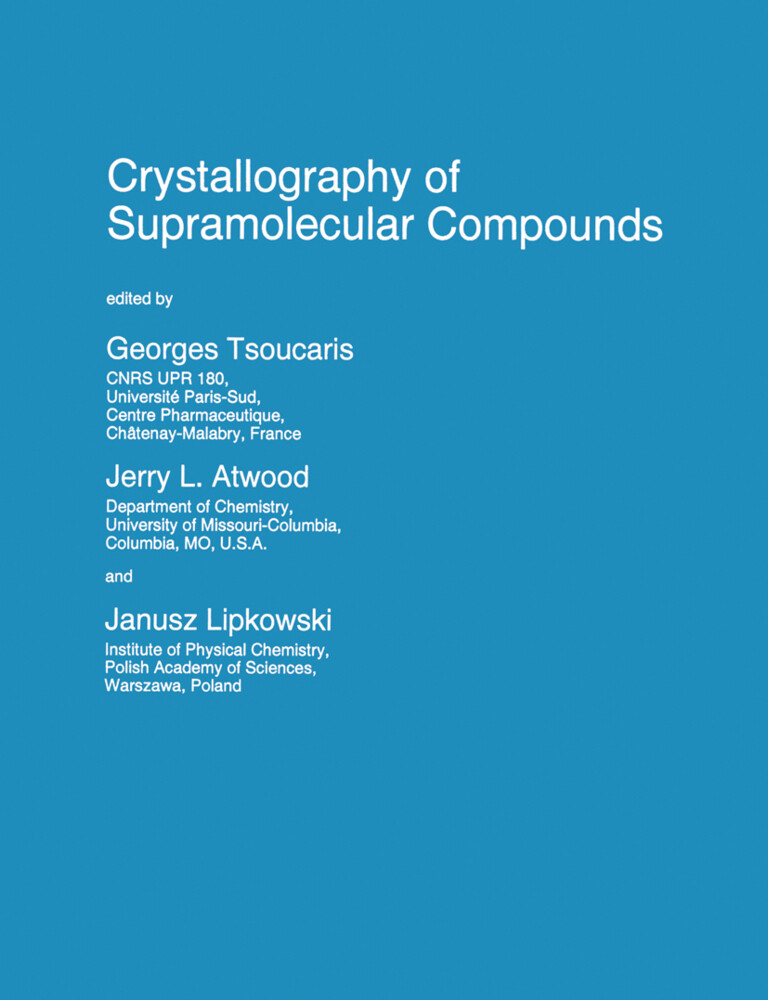
Zustellung: Do, 24.07. - Mo, 28.07.
Versand in 7 Tagen
VersandkostenfreiBestellen & in Filiale abholen:
The Supramolecular Compounds refer to organised multi-molecular assemblies and associated phenomena. The stability and the properties of these compounds strongly involve structural three-dimensional (3D) information. The crystal itself can be considered as a giant supermolecule. Thus, a thorough understanding of crystal structures and crystal growth provides a unique information on the intermolecular interactions. Indeed, each crystal reflects in a particular way the recognition properties of molecules. More so, modern crystallography allows to study in detail two or three-component crystalline solids in which the recognition processes can be seen from the structural standpoint. Crystallography of smaller and smaller single crystals, faster and faster experiments, time-resolved x-ray crystallography, are extremely potent source of physico-chemical information. The present Advanced Study Institute (A. S. I.) - which was planned five years ago as the 22nd Course of the International School of Crystallography (director: T. L. BLUNDELL), 1-11 June 1995, E. Majorana Centre, Erice, Italy - is probably the first international meeting specifically devoted to the Crystallography of Supramolecular Compounds. The presence of crystallographers, chemists and physicists enhanced the coherence of the typical sequence: Conception and Design - Synthesis - Structure and Visualisation - Properties. The interactive and interdisciplinary character of this research is central to the development of general structural models for a large spectrum of compounds: ionophores, cryptates, fullerenes, calixarenes, cyclodextrins, cyclotriveratrylenes, pillar type compounds, zeolites, hydrates, solvates and others.
Inhaltsverzeichnis
1) An introduction to the crystallography of supramolecular compounds. . - 2) Association of helical peptides and ion channels. . - 3) On molecular recognition in fullerene chemistry. . - 4) Long range order in organized monolayers. . - 5) Applications of the Cambridge Structural Database in the study of non-covalent interactions. . - 6) Solvent and dynamic effects on the structure of alkali cation complexes of the t-butyl-calix[4]arene anion: MD and FEP computer investigations on the Na+/Cs+ binding affinity. . - 7) Solid state NMR in inclusion compounds. . - 8) The single crystal as a super molecule. . - 9) New layered and pillared-type compounds, their intercalation chemistry and applications. . - 10) Molecular tectonics. . - 11) Symmetry in spheroalcanes, fullerenes, tubules and other column-like aggregates. . - 12) Stability, solvent patterns and molecular recognition in cyclodextrins. . - 13) Constitution and stability of clathrate hydrates. . - 14) Cyclodextrins and fragments of starch and cellulose: crystal structures, self-assembly and hydrogen bonding. . - 15) Clathration and solvation of molecules. . - 16) Inclusion compounds: relating structure to kinetics and thermodynamics. . - 17) The self-assembly of guanosine derivatives and folic acid. . - 18) Tailor-made auxiliaries for the control of nucleation, growth and dissolution of crystals. . - 19) Synthetic receptors: a modular approach to large structures. . - 20) Structural models of biological significance from supramolecular systems. . - 21) How DNA is recognized by proteins. - 22) Catalytic antibodies: an intriguing host-guest system. . - 23) Supramolecular Organization of keratinized tissue. . - 24) Molecular recognition: the lipocalins. . - 25) Supramolecular photochemical reactions of organic molecules adsorbed on porous crystalline zeolites. . - 26) Topics in supramolecular chemistry. . - Appendix Tutorials on Molecular Modelling. - 1) Introduction to conformational analysis with the macromodel software. . - A. Varnek. - G. Wipff. - 2) Display of dynamic Structures from molecular dynamics simulations in aqueous/non-aqueous solutions. Comparison with X-ray structures. . - A. Varnek. - E. Engler. - M. Lauterbach. - L. Troxler. - G. Wipff. - 3) Harmony: the supramolecular database management system. . - M. Bailly. - E. Eliopoulos. - G. Tsoucaris. - 4) Molecular graphics approaches in structure prediction and determination. . - E. Eliopoulos. - I. M. Mavridis. - 5) An interactive-kinetic approach to the study of supramolecular structures. . - E. Eliopoulos. - I. M. Mavridis. - Attached PC floppy disk. - 6) The Cambridge Structural Database. see p. 55. - F. Allen. - O. Johnson.
Produktdetails
Erscheinungsdatum
31. Mai 1996
Sprache
englisch
Auflage
1996
Seitenanzahl
540
Reihe
Nato Science Series C:
Herausgegeben von
J.L Atwood, Janusz Lipkowski, Georges Tsoucaris, Jerry L. Atwood
Verlag/Hersteller
Produktart
gebunden
Abbildungen
XIV, 520 p.
Gewicht
969 g
Größe (L/B/H)
241/160/34 mm
ISBN
9780792340515
Entdecken Sie mehr
Bewertungen
0 Bewertungen
Es wurden noch keine Bewertungen abgegeben. Schreiben Sie die erste Bewertung zu "Crystallography of Supramolecular Compounds" und helfen Sie damit anderen bei der Kaufentscheidung.










